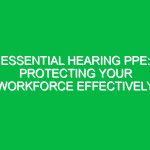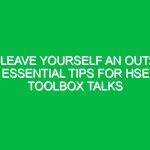Introduction
Hearing protection is required when workers are exposed to potentially hazardous noise levels that can lead to irreversible hearing loss. This issue is especially crucial in the Health, Safety, and Environment (HSE) domain, where safeguarding employee health and ensuring a safe workplace are paramount. In industries such as construction, manufacturing, and mining, where loud machinery and equipment are commonplace, understanding when and how to implement hearing protection is essential. This article explores the significance of hearing protection, the regulatory landscape, and Best Practices for maintaining auditory health in various work environments.
Understanding Hearing Protection
Hearing protection can take many forms, from earmuffs to earplugs. The primary function of these devices is to reduce the intensity of sound reaching the inner ear, thereby preventing noise-induced hearing loss (NIHL). According to the World Health Organization (WHO), approximately 1.1 billion young people are at risk of hearing loss due to recreational exposure to loud sounds. It’s not just about reducing sound; it’s about preserving health.
The Occupational Safety and Health Administration (OSHA) sets the permissible noise exposure limits that dictate when hearing protection is required. As a general rule, if the noise level exceeds 85 decibels (dB) averaged over an eight-hour work shift, hearing protection is required. The scale of sound is logarithmic; that is, every 3 dB increase doubles the sound intensity. Therefore, understanding this scale is crucial for implementing effective hearing protection strategies.
Key Aspects of Hearing Protection
Noise Assessment
Before determining when hearing protection is required, it’s essential to conduct a thorough noise assessment. This involves measuring sound levels using a sound level meter, identifying noise sources, and evaluating the duration of exposure. A competent person, such as a Safety officer or industrial hygienist, should carry out this assessment.
The results will help employers decide on the type of hearing protection needed, whether it be passive devices like earplugs or active devices like electronic earmuffs that amplify low sounds while blocking out harmful noise.
Types of Hearing Protection
There are two main types of hearing protection:
- Earplugs: These are small devices inserted into the ear canal to block sound. They come in various forms including disposable, reusable, and custom-molded options.
- Earmuffs: These cover the entire outer ear and create a seal to reduce noise. They are often more comfortable for prolonged use and can be worn over earplugs for enhanced protection.
Choosing the right type of hearing protection depends on several factors, including the noise level, the work environment, and individual comfort preferences.
Personal Responsibility and Training
Even the best hearing protection is ineffective if not used correctly. Employee training is vital in ensuring that workers understand the importance of hearing protection and know how to use it properly. Regular training sessions should cover:
- Identifying hazardous noise levels
- Proper fitting and Maintenance of earplugs and earmuffs
- Recognizing early signs of hearing loss
Creating a culture of Safety where employees feel responsible for their hearing health can lead to better compliance with hearing protection protocols.
Potential Hazards and Risks
The risks associated with inadequate hearing protection extend beyond physical health. Noise-induced hearing loss not only affects an individual’s quality of life but can also lead to decreased productivity, increased accidents, and higher healthcare costs.
Consider a construction site where workers are exposed to noise levels exceeding 100 dB. Prolonged exposure without appropriate hearing protection can lead to irreversible damage. A case study from a manufacturing plant revealed that after implementing a comprehensive hearing conservation program, including regular noise assessments and mandatory hearing protection, the incidence of NIHL decreased by 40%. This illustrates the profound impact that proper hearing protection can have on worker health and safety.
Regulations and Standards
In the HSE context, various Regulations govern when hearing protection is required. osha’s Noise Standard (29 CFR 1910.95) outlines the permissible noise exposure limits and the responsibilities of employers regarding hearing conservation programs.
The key elements of the standard include:
- Monitoring: Employers must monitor noise levels and maintain records.
- Hearing Conservation Program: If noise exposure exceeds 85 dB, employers must establish a program that includes noise monitoring, employee training, and providing hearing protection.
- Annual Hearing Tests: Employees exposed to high noise levels should undergo regular audiometric testing to detect hearing loss early.
Understanding these regulations is crucial for organizations to ensure compliance and safeguard employee health.
Best Practices for Implementing Hearing Protection
Implementing effective hearing protection goes beyond simply providing devices; it requires a systematic approach. Here are several Best Practices:
1. Conduct Regular Noise Assessments
Employers should conduct periodic noise assessments to identify changes in the work environment that may require updated hearing protection strategies.
2. Engage Employees
Involve employees in the development of hearing conservation programs. Their insights and experiences can help tailor the program to meet the specific needs of the workplace.
3. Promote a Hearing Conservation Culture
Encourage a workplace culture where hearing protection is not just a requirement but a shared value. Hold regular meetings to discuss hearing health and share personal stories about the importance of preserving hearing.
4. Make Hearing Protection Accessible
Ensure that hearing protection devices are readily available and easy to use. Regularly check that devices are in good condition and replace them as needed.
5. Evaluate and Adapt
Regularly evaluate the effectiveness of the hearing conservation program. Solicit feedback from employees and adapt the program to address any shortcomings or emerging issues.
Conclusion
Hearing protection is required when workers are exposed to hazardous noise levels, and understanding this requirement is essential for promoting health and safety in the workplace. Through regular noise assessments, employee training, and adherence to regulatory standards, employers can create a safer environment that prioritizes auditory health.
As we move forward, it’s crucial for both employers and employees to recognize the significance of hearing protection not only as a regulatory obligation but as a fundamental aspect of Workplace Safety. Protecting our hearing today ensures our quality of life tomorrow. By fostering a culture of safety and awareness, we can mitigate the risks associated with noise exposure and promote a healthier, more productive workforce.


